Development and assessment of an evidence-based prostate cancer intervention programme for black men: the W.O.R.D. on prostate cancer video
Folakemi Odedina1, 2, Awoyemi O Oluwayemisi1, Shannon Pressey1, 2, Samuel Gaddy2, 3, Eva Egensteiner4, Ezekiel O Ojewale1, Olivia Myra Moline5 and Chloe Marie Martin6
1University of Florida, Gainesville, FL 32610, USA
2Florida Prostate Cancer Health Disparity Research Group, University of Florida, P.O. Box 100496, Gainesville, FL 32610, USA
3Alachua County Prostate Cancer Alliance, Gainesville, FL 32608, USA
4Egensteiner Media Consulting, LLC, Gainesville, FL 32605, USA
5Florida A&M University, 1520 Martin Luther King Jr Blvd, Tallahassee, FL 32307, USA
6Howard University, 2400 Sixth St NW, Washington, DC 20059, USA
Correspondence to: Folakemi Odedina, PhD. Email: fodedina@cop.ufl.edu
Abstract
In spite of the numerous prostate cancer (CaP) intervention programmes that have been implemented to address the disparities experienced by black men, CaP prevention, risk reduction, and early detection behaviours remain low among black men. The lack of formal theoretical frameworks to guide the development and implementation of interventions has been recognised as one of the primary reasons for the failure of health interventions. Members of the Florida Prostate Cancer Health Disparity (CaPHD) group employed the Personal Model of Prostate Cancer Disparity (PIPCaD) model and the Health Communication Process Model to plan, implement, and evaluate an intervention programme, the ‘Working through Outreach to Reduce Disparity (W.O.R.D. on Prostate Cancer)’ video for black men. The location for the video was in a barbershop, a popular setting for the targeted group. The video starred CaP survivors, CaP advocates, a radio personality, and barbers. In addition, remarks were provided by a CaP scientist, a urologist, a CaP advocate, a former legislator, and a minister.
The W.O.R.D. video was developed to assist black men in meeting the Healthy People 2020 goal for the United States of America. The efficacy of the W.O.R.D. video was successfully established among 143 black men in Florida. Exposure to the video was found to statistically increase CaP knowledge and intention to participate in CaP screening. Furthermore, exposure to the video statistically decreased participants’ perception of the number of factors contributing to decision, uncertainty about CaP screening. Participants were highly satisfied with the video content and rated the quality of the video to be very good. Participants also rated the video as credible, informative, useful, relevant, understandable, not too time consuming, clear, and interesting.
Keywords: prostate cancer, black men, education intervention, prostate cancer video, prostate cancer disparity
Copyright: © the authors; licensee ecancermedicalscience. This is an Open Access article distributed under the terms of the Creative Commons Attribution License (http://creativecommons.org/licenses/by/3.0), which permits unrestricted use, distribution, and reproduction in any medium, provided the original work is properly cited.
Introduction
The American Cancer Society (ACS) estimated that there will be about 233,000 new cases of prostate cancer (CaP) in the United States (US) in 2014, and about 29,480 men will die from the disease [1]. While there has been a decline in CaP mortality and morbidity since the 1990s, black men in the US are still disproportionately affected by CaP. In 2013, CaP accounted for 37% of all cancers diagnosed in black men [2]. The CaP incidence rate for black men was 70% higher than that of white men, while the CaP death rate was more than twice as high in black men compared to white men in 2013 [1]. Between 2005 and 2009, the average annual CaP incidence rate among black men was 63% higher compared to white men. The disproportionate burden of CaP seen in black men can be attributed to personal, provider, institutional, or health systems factors [3]. The modification of personal factors, through behavioural intervention programmes, is one of the key strategies to eliminate the CaP health disparity experienced by black men.
The personal factors of black men that have been linked to CaP disparity include low CaP knowledge [4–7], low CaP risk awareness, [8–10], and late CaP detection activities [11, 12] To address these personal factors, numerous community-based intervention programmes have been developed to enhance black men’s CaP awareness, knowledge, and early behaviours. [7, 13–16] Although some of these intervention programmes demonstrated effectiveness during the active phase of implementation, the successes have been short term. According to Green and Glasgow, most health interventions fail in targeted communities because they are impractical [17, 18]. Another reason for the failure of intervention programmes is that most are not guided by comprehensive, valid, and culturally appropriate behavioural theories. The lack of theory-based interventions greatly impacts the sustainability of prostate health intervention programmes for black men. For example, published studies continue to show that black men have limited CaP knowledge [4–7], especially with respect to personal risk assessment, and report low CaP screening [6, 19, 20].
Based on over 10 years of research, the Florida Prostate Cancer Health Disparity Research (CaPHDR) group developed a Personal Integrative Model of Prostate Cancer Disparity (PIPCaD) for black men [4–6, 19–23]. The PIPCaD model (see Figure 1) hypothesises that a potential source of CaP disparity in black men is their personal behavioural factors such as lack of CaP risk reduction behaviours, and early CaP detection behaviours. The risk reduction behaviours include lifestyle factors such as healthy eating and exercise. Early detection behaviours include informed screening decision. The personal factors are in turn impacted by cognitive-behavioural factors (such as knowledge and health beliefs), cultural beliefs and values, and socio-demographic factors. Our central hypothesis is that an intervention programme based on a theoretical framework that predicts black men’s behaviours will succeed in improving CaP risk reduction and early detection behaviours among black men. Based on this central hypothesis, we developed the ‘W.O.R.D on Prostate Cancer Video’ (https://www.youtube.com/watch?v=74NPk6u_wcw), a prostate cancer education video, designed to close the CaP disparities gap between black men and white men.
In line with our long-term goal of improving prostate health in minority, rural, and under-served communities, the W.O.R.D video focuses on explaining the risk factors for CaP, how to reduce the risk for CaP, and informed decision making about CaP screening. The W.O.R.D video addressed the limitations of previous CaP intervention programmes for black men using two innovative strategies. The first strategy was the use of a theoretical framework, the PIPCaD model, to plan and develop a video. The PIPCaD model provided information on the behavioural factors to target the CaP education intervention, including: attitude, perceived severity, perceived susceptibility, cues to action, knowledge, and perceived behavioural control. The CaP screening facilitators and deterrents targeted are summarised in Table 1. Based on the PIPCaD model, the W.O.R.D video was developed to promote CaP risk reduction and early detection behaviours among black men by: (i) increasing awareness and knowledge about CaP and CaP prevention; (ii) supporting informed decision making about screening; (iii) promoting positive attitudes, beliefs, and practices relative to CaP prevention; and (iv) addressing barriers and facilitators to prostate screening and prostate health. Thus, the W.O.R.D video has the potential to change behaviour.
Table 1. Prostate cancer behavioural factors addressed in the W.O.R.D video.
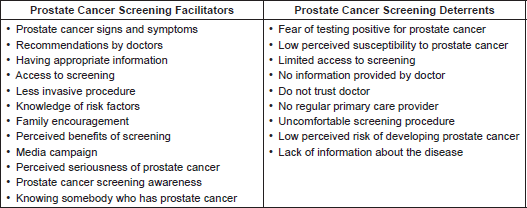
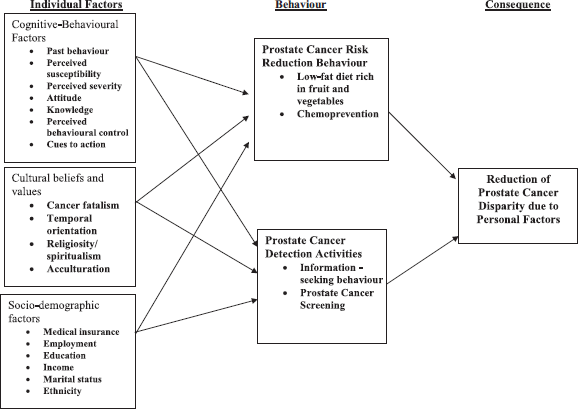
Figure 1. An integrative personal model of prostate Cancer disparity (PIPCaD Model) for African American men.
The second strategy is the use of the Health Communication Process Model [24] to ensure the successful development of the programme. The intervention is based on the six stages of continuous process of planning and improvement proposed by the Health Communication Process Model. The stages are: (1) planning and strategy selection, (2) selecting channels and materials for the intervention, (3) developing materials and pre-testing, (4) implementation of intervention, (5) assessing effectiveness of intervention, and (6) feedback to refine the programme. This study focused on the development and testing of the efficacy of the W.O.R.D video (Stage 3).
Study objective
The primary goal of this study was to develop a video intervention that will improve the prostate health behaviour of black men. To accomplish this goal, the study objectives were to:
1. Develop a culturally relevant CaP education intervention, the W.O.R.D video, for black men based on the PIPCaD model.
2. Evaluate participants’ general assessment of the W.O.R.D video, including satisfaction with and perceived quality of the video.
3. Establish the efficacy of the W.O.R.D video in improving users’ CaP knowledge and CaP screening intention as well as reducing decisional conflict about CaP screening.
Methods
Study intervention: The W.O.R.D on prostate cancer video
The intervention programme was based on the PIPCaD model, which provided the understanding on the needs and perceptions of black men. The strategy statement for the intervention programme (see Table 2) was developed from the PIPCaD variables. Based on the strategy statement, the intervention includes: (1) reliable communication messages that provides culturally appropriate information on CaP for black men; (2) an efficient communication channel, a video, to facilitate the personal delivery of the interventions, increase and sustain knowledge, and promote CaP risk reduction behaviours as well as regular doctor’s visit for informed decision on early detection behaviours; and (3) trustworthy communication sources, including CaP survivors, a physician, a scientist, and a minister.
The intervention channel
The primary intervention channel for the W.O.R.D programme is the video. Video has been found to be one of the most effective channels for educating black men [25, 26]. It has also been used as a critical medium to promote diverse health issues. In a review of 175 studies (mostly conducted in the US), Eiser and Eiser [27] concluded that video is an effective communication tool for health interventions if it is grounded in behavioural theory and engages the audience. These authors also note that: (1) video can change attitudes and knowledge, (2) video can change behaviour if ‘actors’ are used to model the behaviour, and (3) video has been documented to increase participation in cancer screening programmes among minority women. The setting for the W.O.R.D video was a barbershop. The barbershop was selected for the setting because it is accessed by black men of diverse educational backgrounds and socio-economic classes [28–30]. Popularly regarded as ‘black men’s country club’, the barbershop has become a noted place to offer health interventions for hard-to-reach black men [13, 30–33].
The intervention sources
The intervention sources were primarily characters that black men can relate to and included: (1) Malik, the barber, a young black man; (2) Mr King, a 62-year-old customer, on his way to get his first prostate check-up; (3) Andre, an older customer, who has been screened regularly for years; (4) Quincy, a mid-40s customer with a comedic personality; (5) Chuck, a CaP survivor; and (6) set extras who were barbers and young customers.
The intervention message
The modifiable variables targeted for the intervention message were: (1) perceived behavioural control; (2) perceived susceptibility to CaP; (3) perceived severity of CaP; and (4) cues to action. A video and multimedia company was hired to produce and direct the video, including pre-production meetings and correspondence with the research team, which included CaP survivors; scriptwriting; video production planning; video shoot of all scenes; and post-production, including editing into final video sequences for website and Digital Video Disc (DVD). The storyline for the script was that Quincy (a black man in his mid-40s) becomes aware of the importance of CaP prevention and having a consultation with a physician for informed decision on screening, and finally decides to discuss it with his doctor after a lively conversation with his friends at a barbershop. A knowledgeable friend and a CaP survivor share key information with Quincy, the barbers, and other customers. While the storyline was anchored on humor, it highlighted specific messages on risk reduction and early detection of CaP. At the end of the video, the CaP message was reinforced by scrolling on the screen and simultaneously announcing information about the CaP risk factors, specific steps that can be taken to reduce an individual’s risk for cancer, the pros and cons of CaP screening, and how to make an informed decision about CaP screening.
Study design, variables and measures
The study was a pre-, post-test research design, exploring the impact of the W.O.R.D video on the following variables: CaP knowledge, CaP screening intention, and decisional conflict. These three variables were selected as the study variables because they have been found to impact CaP risk reduction and screening behaviours [4–10]. Table 3 provides the definition of the study variables. The CaP knowledge, CaP screening intention and demographic information scales were developed and validated in previous studies by the Florida CaPHDR group [4–6, 19–23]. The measure of decisional conflict was adapted from the scale developed by O’connor [34]. In addition to the study variables, measures of satisfaction with and quality of the video were assessed after exposure to the intervention. The demographic information of participants and information on access to medical services were also assessed.
Table 2. Strategy statement for the PIPCaD programme.
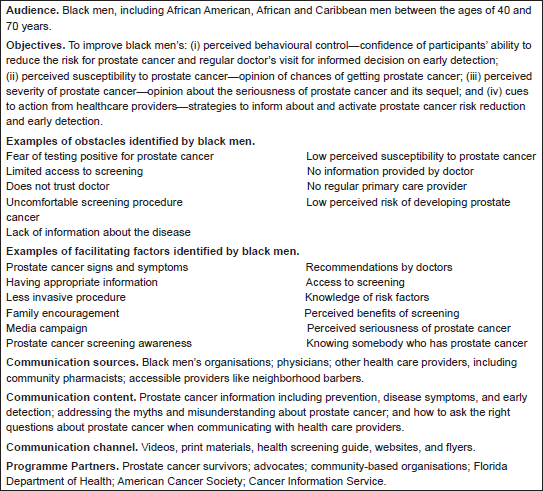
Table 3. Conceptual and operational definitions of study variables.
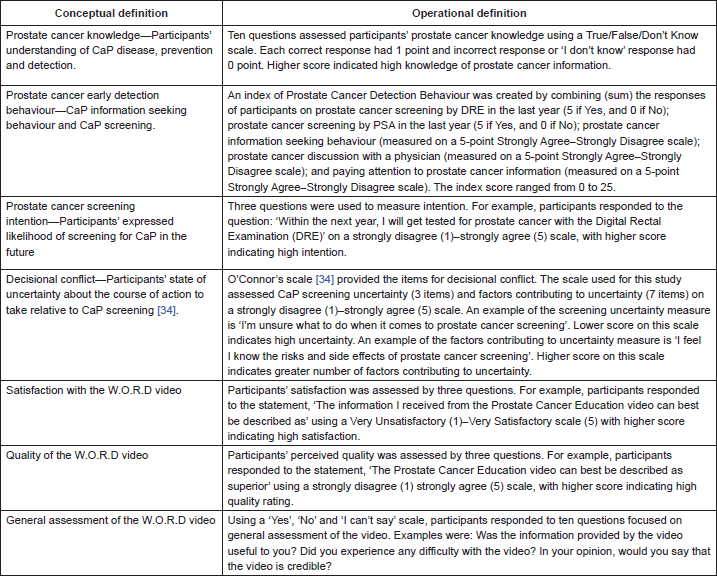
Study setting and participants
The study setting for this project was Alachua and Orange counties in Florida. The inclusion criteria were black men, age 35 and above, regardless of CaP history. Men who were not black men of African ancestry and who were unable to speak English were excluded from participating in the study. Participants were recruited at health forums and community outreach events, including the African American Men’s Summit in Orlando, the Men’s Health Expo in Gainesville, and the University of Florida mobile health clinics in Gainesville. Participants were recruited by undergraduate research assistants, including the University of Florida-Florida A&M University ReTOOL students as part of their CaP research training experience. The research assistants approached black men at these events and asked if they would like more information about the study or have any questions about participating in the study. Only the men who indicated an interest in participating in the study were included after verbal consent.
Data collection
Institutional Review Board (IRB) approval for the project was received on 29 March 2012. Subsequently, data were collected prospectively from participants between 1 April 2012 and 16 June 2012. Data collection included the following three steps:
Step 1: Participants completed a self-administered pre-test survey measuring CaP knowledge, CaP screening intention, decisional conflict, medical access information, and demographic information.
Step 2: Participants viewed the W.O.R.D video. The video was viewed in groups of 5–10 depending on the study site.
Step 3: Following the viewing of the W.O.R.D video, participants completed a self-administered post-test survey measuring CaP knowledge, CaP screening intention, decisional conflict, satisfaction with the W.O.R.D video, perceived quality of the W.O.R.D video, and general assessment of the W.O.R.D video.
The survey instructions noted that participants may choose not to answer all of the survey questions and they may withdraw from the study at any time. During data collection, participants who asked for assistance in completing the survey, mostly due to difficulty in reading, were assigned a research assistant to assist them in completing the survey. A US$10–15 Wal-Mart gift card was provided to all participants as an incentive for their participation.
Data analysis
The survey data were coded and stored in a Microsoft (MS) Excel database. Subsequently, Psychological Clinical Science Accreditation System (PC-SAS) analytical software was employed for data cleaning and analyses. Frequency analysis was first conducted to confirm that the responses were appropriately entered and to correct any errors. The statistical analyses included: internal consistency of the study scales to establish the reliability of the measures; descriptive statistics to summarise socio-demographic, and study variables; and T-test analyses to check the changes in key study variables between pre- and post-intervention exposure.
Results and discussion
Our primary goal was to develop an education intervention programme that will improve the prostate health behaviour of black men and establish the efficacy of the programme. Based on the Health Communication Process [24], we accomplished this goal by answering the following questions: (1) What should black men be told? (2) How do black men react to the message concepts for the W.O.R.D. video? (3) Do black men understand the message of the W.O.R.D. video, accept its importance, and agree with the value of the solution? (4) How do black men respond to the message format? (5) Based on responses from the black men, do changes need to be made in the message or in its format?
The final version of the W.O.R.D video was produced on 28 February 2012. Two versions of the video were produced. The full version is about 25 minutes long and the short version is about 14 minutes long. The short version is hosted on YouTube (see http://www.youtube.com/watch?v=74NPk6u_wcw). Figure 2 is a pictorial summary of one of the scenes from the video. A total of 142 participants were recruited to establish the efficacy of the W.O.R.D video. Based on a statistical power of 0.80, a medium effect size (0.5), and probability level of 0.05 to is required to establish statistical significance, and the minimum sample size required for a two-tailed hypothesis is 128. With a sample size of 142, the study was sufficiently powered to explore the research objectives. The reliability of the study scales were: 0.76 for Intention pre-test scale; 0.70 for satisfaction scale; 0.78 for perceived quality scale; and 0.86 for intention post-test scale. All the scales were found to be reliable based on Nunnaly’s [35] suggestion of 0.70 to be an acceptable reliability coefficient.
Table 4 provides a summary of the characteristics of study participants. The study participants were mostly US-born black men, between 50 and 59 years, married, urban residents, who had full-time employment, with an education level of high school diploma, and earned less than US$20,000. In addition, most of the participants had insurance and access to a primary care provider. The majority of the participants were recruited from the African American Men’s Health Summit held at the Orange County Convention Centre in Orlando. Given that the majority of the men who attend the summit have participated for many years, our expectation was that their CaP knowledge and intention to screen for CaP would be relatively high.
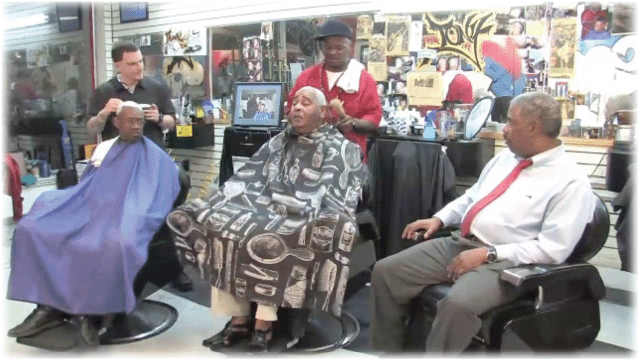
Figure 2. W.O.R.D. Video Scene.
Table 4. Participants’ demographic and health characteristics.

Table 5. Participants’ responses on study variables and T-Test results for pre- and post-test analyses.

Participants’ prostate cancer knowledge, intention to screen, and decisional conflict
A summary of participants’ responses on the study variables is provided in Table 5. The mean pre-test knowledge score was 63.6%, and the mean post-test knowledge score after intervention exposure was 74.0%. Table 6 provides additional details on the performance of participants on the knowledge scale. The questions that participants were least knowledgeable about (scored less than 60%) were: (1) I should be able to tell immediately if I have prostate problem; (2) Having somebody in your family with prostate cancer increases the chance of getting prostate cancer; (3) A diet high in fat will decrease the chance of getting prostate cancer; (4) Doing only one of the tests, prostate-specific antigen (PSA) or the digital rectal exam (DRE), is enough to test for prostate cancer; and (5) Early screening for prostate cancer cannot tell if one has prostate cancer. Interestingly, there was an increase in the overall performance of participants on all knowledge items after watching the W.O.R.D video, including the five areas of difficulty noted above.
The behavioural intention of participants relative to participating in CaP screening within the next year was measured by three items with a scale ranging from 3 to 15. As expected, the baseline intention of the participants was high given that the majority of the participants were recruited at a health summit. The pre-test score was 12.78 and the post-test score 13.37. While the baseline score of participants on the intention scale was high, the intervention exposure slightly increased the mean score of participants on this scale.
According to O’Connor [34], decisional conflict is a participant’s state of uncertainty about the course of action to take when making choices involving risk or uncertainty of outcomes, such as the decision to screen for CaP. The decisional conflict scale (DCS) comprises three subscales: (1) uncertainty; (2) selected factors contributing to the uncertainty (referred to as uncertainty factors); and (3) perceptions of effective decision making. The first two subscales were adapted for this study. Participants’ pre-test score on decision uncertainty was 10.44 on a scale ranging from 3 to 15. The post-test score was 10.81. A lower score on the uncertainty scale indicates high uncertainty. Thus, the uncertainty of participants decreased slightly after watching the W.O.R.D video. The second subscale for the decisional conflict scale is uncertainty factors. Seven items were used to assess this subscale, with scale score ranging from 7 to 35. A higher score on this scale indicates greater number of factors contributing to uncertainty. The pre-test score on the uncertainty factor subscale was 17.31, and the post-test score 16.42. Similar to the uncertainty subscale, the number of uncertainty factors perceived by participants decreased slightly after watching the W.O.R.D video.
Participants’ assessment of the W.O.R.D video
In general, the assessment of the W.O.R.D. video was highly positive. Over 90% of the participants indicated that they were satisfied with the video, and 80% of the participants indicated that the quality of the video was high. The mean satisfaction rating was 13.67 on a scale ranging from 3 to 15, indicating a highly satisfactory rating for the video. The mean quality score was 12.19 on a scale ranging from 3 to 15, indicating very good rating. Table 7 provides a summary of participants’ assessment of the W.O.R.D. video. Over 75% of the participants indicated that: (1) the information provided by the video was useful to them; (2) they understood all the words used in the video; (3) they did not feel that the video was too long or too time consuming; (4) they did not find any of the information on the video embarrassing; (5) they did not experience any difficulty with the video; (6) the video was relevant to them; (7) the video got their attention; (8) the video has the potential to increase CaP knowledge among black men; and (9) they found the video to be credible. These assessments indicate the comfort level of participants with the video. This is especially important given that the majority of the participants’ educational level was high school diploma.
Table 6. Participants’ responses on knowledge scale pre- and post-intervention exposure.
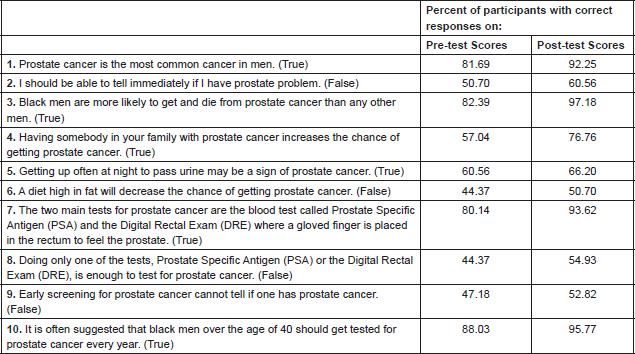
Table 7. General assessment of W.O.R.D video.

The use of video as an intervention channel has several advantages as a powerful communications vehicle, including the fact that [27] (1) it is vivid and graphic; (2) it enabled us to display real-life situations through actors; (3) it facilitated communication of appropriate behaviour for the audience; (4) it facilitated the provision of the information in a very lively and humorous way; (5) it fostered engagement of the audience, thereby encouraging them; (6) the actors were able to personalise the issues presented on the video; (7) as noted by the participants, the video overcame difficulties with literacy; and (8) it will continuously engage the population through social media, in this case YouTube. It is interesting to note that the participants did not indicate a preference for viewing the video in a health care setting. When asked whether they would feel more comfortable viewing the video at a health care office (such as a doctor’s office, pharmacy, or clinic), only 42% of the participants indicated yes. Our goal was to have black men feel comfortable viewing the video in any setting, including barbershops. Almost 60% of the participants indicated that they would be comfortable viewing the video outside a health care setting.
Efficacy assessment of the W.O.R.D video
Student’s T-test analysis was conducted to compare the differences between the means of the pre-test scores and post-test scores on CaP knowledge, intention to screen for CaP, decision uncertainty and uncertain factors after the intervention exposure. A summary of the T-test results is provided in Table 6. Based on the p-values, exposure to the W.O.R.D video statistically improved CaP knowledge, increased intention to screen for CaP within the next year, and decreased participants’ perception of the number of factors contributing to uncertainty about CaP screening. Although the uncertainty of participants relative to making a decision about CaP screening decreased slightly after watching the W.O.R.D video, the decrease was not statistically significant. This may be because it may be necessary for the participants to review additional information and process the information in order to effectively impact decision uncertainty. In this case, print media would be ideal to reinforce the information on the video. Subsequently, an educational brochure based on the information presented in the W.O.R.D. video has been developed. A wallet-size screening information card has also been developed for black men to document the results of their screening tests. The card also lists the risk factors for CaP. In addition to providing chart fields to record CaP test results for five years, the card serves as a reminder to discuss CaP screening with a physician annually.
Conclusions
Black men were the only racial group that did not meet the CaP Healthy People 2010 goal for the US to reduce the CaP death rate to 28.8 deaths per 100,000 males by 2010 [36]. Between 2005 and 2009, the CaP death rate for black men was 53.1/100,000 compared to 21.7/100,000 for white men [2]. While black men are yet to meet the Healthy People 2010 goal for CaP, the Healthy People 2020 goal target is 21.2 CaP deaths per 100,000 men [37]. For black men, the Healthy People goal may continuously be a moving target that remains unattainable unless an intervention that effectively addresses the factors that have been noted to cause CaP disparity in this at-risk group is implemented.
The W.O.R.D. video was developed to assist black men in meeting the Healthy People 2020 goal for the USA. The efficacy of the W.O.R.D. video was successfully established among 143 black men in Florida. Exposure to the W.O.R.D. video was found to statistically increase CaP knowledge and intention to participate in CaP screening. Furthermore, exposure to the W.O.R.D. video statistically decreased participants’ perception of the number of factors contributing to decision uncertainty about CaP screening. Participants were highly satisfied with the video content and rated the quality of the video to be very good. Participants also rated the video as credible, informative, useful, relevant, understandable, not too time consuming, clear, and interesting.
It is important to note that the benefits of CaP screening for the general population remain controversial. However, given the disproportionate burden of CaP in black men and the lack of clinical trials to assess the effectiveness of screening in black populations, the only strategy we currently have to combat CaP disparity for black men is the early detection of CaP. The W.O.R.D. video promotes informed decision making by black men, listing the pros and cons of CaP screening.
This project only focused on the short-term impact of the W.O.R.D. video, focusing on its efficacy and not the effectiveness in real life settings. The next step would be to assess the effectiveness and uptake of the intervention. While there are several advantages to providing CaP education at barbershops, as pointed out above, it is important to note that this cannot serve as a surrogate to talking with a healthcare provider. The W.O.R.D. video intervention is likely to be more effective in barbershops if the barbers are trained to be prostate health advisers. In the absence of trained barber health advisers, the barbers will need to navigate their clients to appropriate health care providers for prostate health education. Another limitation is the representation of participants. Since participants were not recruited randomly and constitute a convenient sample, they are not representative of all black men. As mentioned above, the participants for the study were more knowledgeable about CaP and had a higher CaP screening intention because of their exposure to CaP information at health forums. In spite of these limitations, the W.O.R.D. video has significant advantages. It was tailored to the specific needs and characteristics of black men because it was developed from information generated from black men on their CaP personal factors. The W.O.R.D. video message is thus credible, relevant, and culturally-responsive to black men. The W.O.R.D. video is also highly accessible nationwide through YouTube, fostering widespread dissemination, at minimal cost. In addition, the W.O.R.D. video DVD and accompany brochures are available at no charge to black men.
Conflicts of interest
There is no conflict of interest reported by authors.
Acknowledgments
Funding for this study was provided by the University of Florida College of Pharmacy and the University of Florida Health Cancer Centre.
The authors would like to thank So Sharp Barbershop, Egensteiner Media Consulting LLC, the Alachua County Prostate Cancer Community Advisory Board, Greater Bethel AME Church, and Central Florida Pharmacy Council for facilitating the production and assessment of the W.O.R.D. video. In addition, Former Senator Anthony ‘Tony’ Hill, Dr Unyime Nseyo, Rev. Karl Smith, Charles Cooper, Roger King, Franklin Donaldson, and Anthony Miranda are acknowledged for their participation in the W.O.R.D. video production. The 2012 ReTOOL programme cohort (Stephanie Alexis, Danielle Anderson, Kacy Flowers, and Tamieka Atkinkson) assisted with the data collection.
References
1. American Cancer Society (2014) Cancer Facts & Figures 2014 Atlanta: American Cancer Society
2. American Cancer Society (2013) Cancer Facts & Figures for African Americans 2013–2014 Atlanta: American Cancer Society
3. Institute of Medicine (2003) Unequal treatment: Confronting Racial and Ethnic Disparities in Healthcare Smedley BD, Stith AY and Nelson AR eds. Washington DC, National Academy Press 1–27
4. Odedina FT et al (2008) Personal Factors Affecting African American men’s prostate cancer screening behavior J Nat Med Assoc 100(6) 724–33.
5. Odedina FT et al (2009) Prostate Cancer Cognitive-Behavioral Factors in a West African Population J of Immigr and Minor Health 11(4) 258–67 DOI: 10.1007/s10903-008-9212-9
6. Odedina FT et al (2011) Within-group differences between native-born and foreign-born black men on prostate cancer risk reduction and early detection practices J Immigr Minor Health 13(6) 996–1004 DOI: 10.1007/s10903-011-9471-8 PMID: 21547350
7. Saunders DR et al (2013) Development of the men's prostate awareness church training: Church-based workshops for African American men Fam Community Health 36(3) 224–35 PMID: 23718958
8. Myers RE et al (2000) Intention to be tested for prostate cancer risk among African-American men Cancer Epidemiol Biomarkers Prev 9(12) 1323–8
9. Bloom JR et al (2006) Family History, Perceived Risk, and Prostate Cancer Screening among African American Men Cancer Epidemiol Biomarkers Prev 15(11) 2167–73 DOI: 10.1158/1055-9965.EPI-05-0738 PMID: 17119042
10. Spain P et al (2008) Perceived family history risk and symptomatic diagnosis of prostate cancer: the North Carolina Prostate Cancer Outcomes study Cancer 113(8) 2180–7 DOI: 10.1002/cncr.23801 PMID: 18798229 PMCID: 2584965
11. Ndubuisi SC et al (1995) White differences in the stage at presentation of prostate cancer in the District of Columbia Urology 46(1) 71–77 DOI: 10.1016/S0090-4295(99)80162-9 PMID: 7604479
12. Freedland SJ and Isaacs WB (2005) Explaining racial differences in prostate cancer in the United States: Sociology or biology? The Prostate 62 243–252 DOI: 10.1002/pros.20052
13. Luque JS et al (2010) Barbers Against Prostate Cancer: A Feasibility Study for Training Barbers to Deliver Prostate Cancer Education in an Urban African American Community J Cancer Educ 25(1) 96–100 DOI: 10.1007/s13187-009-0021-1 PMID: 20146044 PMCID: 2862382
14. Drake BF et al (2010) A church-based intervention to promote informed decision making for prostate cancer screening among African American men J of the Natl Med Assoc 102(3) 164–71
15. Hail IJ et al (2011) Discussions About Prostate Cancer Screening Between U.S. Primary Care Physicians and Their Patients J Gen Intern Med 26(10) 1098–104 DOI: 10.1007/s11606-011-1682-0
16. Patel K et al (2012) A community-driven intervention for prostate cancer screening in African-Americans Health Educ Behav 40(1) 11–8 DOI: 10.1177/1090198111431275 PMID: 22508702
17. Green LW and Glasgow RE (2006) Evaluating the relevance, generalization, and applicability of research: Issues in external validation and translation methodology Eval Health Prof 29(1)126–53 DOI: 10.1177/0163278705284445 PMID: 16510882
18. Glasgow RE et al (2006) Evaluating the impact of health promotion programs: Using the RE-AIM framework to form summary measures for decision making involving complex issues Health Educ Res 21(5) 688–94 DOI: 10.1093/her/cyl081 PMID: 16945984
19. Odedina FT et al (2011) Prostate cancer health and cultural beliefs of black men: The Florida Prostate Cancer Disparity Project. Infectious Agents and Cancer 6(Suppl 2) S10
20. Odedina FT et al (2011) Modifiable Prostate Cancer Risk Reduction and Early Detection Behaviors in black men Am J Health Behav 35(4) 470–484 DOI: 10.5993/AJHB.35.4.9 PMID: 22040593
21. Odedina FT et al (2000) African American males' views on prostate cancer screening Minority Health Today 1(6) 28–34
22. Odedina FT et al (2004) A naturalistic study of factors influencing African American men’s prostate cancer screening behavior J Natl Med Assoc 96(6) 780–8 PMID: 15233488 PMCID: 2568374
23. Kumar NB et al (2009) Comparing Dietary and other Lifestyle Factors among immigrant Nigerian Men living in the US and Indigenous Men from Nigeria: Potential Implications for Prostate Cancer Risk Reduction. Journal of Immigrant and Minority Health J Immigr Minor Health 11(5) 391–9 Epub 2009 Feb 19 DOI: 10.1007/s10903-009-9231-1 PMID: 19225888
24. National Cancer Institute Publication Making health communication programs work: A planner’s guide (NCI Office, 6116 Executive Boulevard, MSC8322, Bethesda, MD 20892-8322)
25. Weinrich S et al (1998) Prostate cancer education in African American churches Public Health Nurs 15(3) 188–195 DOI: 10.1111/j.1525-1446.1998.tb00338.x PMID: 9629032
26. Kripalani S et al (2007) Low-Literacy Intervention to Promote Discussion of Prostate Cancer: A Randomized Controlled Trial Am J Prev Med 33(2) 83–90 DOI: 10.1016/j.amepre.2007.03.018 PMID: 17673094 PMCID: 1986767
27. Eiser RJ and Eiser C (1996) Effectiveness of video for health education: A review Health Education Authority London
28. Staten V (2001) Do Bald Men Get Half-price Haircuts?: In Search of America’s Great Barber Shops 1st ed (New York, NY: Simon & Schuster)
29. Bristol D (2004) From outposts to enclaves: a social history of black barbers from 1750 to 1915 Enterprise and Society 5 594–606 DOI: 10.1093/es/khh079
30. Marberry C (2005) Cuttin’ Up: Wit and Wisdom from Black Barber Shops (New York, NY: Doubleday)
31. Hart A Jr and Bowen DJ (2004) The feasibility of partnering with African-American barbershops to provide prostate cancer education Ethn Dis 14(2) 269–73 PMID: 15132213
32. Luque JS et al (2011) Barbershop communications on prostate cancer screening using barber health advisers Am J Mens Health 5(2) 129–39 DOI: 10.1177/1557988310365167
33. Li J et al (2011) Promoting men’s health within barbershops: Barber/owner survey results and implications for intervention planning Prev Med 53(3) 207–208 DOI: 10.1016/j.ypmed.2011.06.001 PMID: 21683732
34. O’Connor AM (1995) Validation of a Decisional Conflict Scale Med Decis Making 15(1) 25–30 DOI: 10.1177/0272989X9501500105 PMID: 7898294
35. Nunnaly J (1978) Psychometric Theory (New York: McGraw-Hill)
36. U.S. Department of Health and Human Services (2010) Office of Disease Prevention and Health Promotion. Healthy People Washington, DC available at http://www.healthypeople.gov/2010/default.aspx. Date accessed: 11 August 2008
37. U.S. Department of Health and Human Services (2020) Office of Disease Prevention and Health Promotion. Healthy People 2020 Washington, DC available at http://www.healthypeople.gov/2020/default.aspx. Date accessed: 23 January 2014






